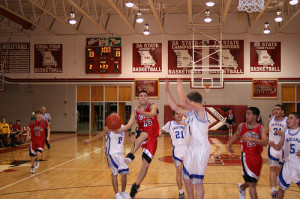Why Do My Players Continue to Miss Lay-ups?

The Lay-up is one of the most widely used skills in basketball. For most players this is their very first technique learnt when attempting to score. The lay-up forms one of the most fundamental skills developed in basketball and so therefore it is often seen as a point of frustration when junior, senior or elite players fail to perform the skill both during training and in games.
The problem is that no one scoring technique will ever be perfect and all skills across the gamut of basketball will need to be rehearsed, broken down, or re-taught from time to time to ensure they continue to be performed at an acceptable level of competence. The lay-up though can have some inherent issues when teaching and then performing. Some common reasons are defined below…
Poor Technique
When players are not well-drilled, they can become very complacent when going through the motions of performing skills. The skill does not need to be simple for this happen, but can be very complex, and still this issue persists. Standards during practice need to be set for the team and then monitored for each individual. Allowing slow repetitions or “loose” technique only serves to create bad habits for players. The lay-up will be a skill that players often become complacent in performing because of its often overuse in similar situations.
Lack of Depth or Confidence in Skill Set
There are a number of different lay-up techniques that can be taught and utilised by a player during a competitive training sessions drills or a game. If a player does not have knowledge or confidence with these various techniques, they will never utilise them and continue to force bad shots, because in their mind they have no other option. For example if a player is looking to perform a lay-up on the right side of the basket and the defender stops this option, if the player does not possess the ability to perform a reverse lay-up on the left hand side, they will more than likely still try to force the right hand lay-up or another poor shot.

Mind Numbing Repetition
Drills can have a very beneficial effect for players when they are starting to learn new techniques and skills. Well thought out drills can provide a great opportunity for skills like the lay-up to be progressively developed, refined and performed.
However, many drills do feature similar aspects such as where the drill starts and the angle they finish at the basketball hoop. This causes players to become accustom to laying the ball up from a particular position or within a certain angle. This is obviously not the case in games and coaches should take notice of the drills they regularly use and look for different ways to finish the scoring movement so players gain variety and experience from other angles when trying to perform a lay-up.
Game Pace
Probably the most common reason across many errors is the poor rehearsal of players during training sessions of skills at a game pace. Players should be encouraged to progress from being introduced to a skill, to attempting to perform the skill at game pace as quickly as possible.
Playing through the Contact
Many developing players struggle with the concept of basketball being a semi-contact sport but the contact around the keyway and to the basket often being heavy at different times. This can cause player to shy away from this contact for fear of being hurt. This in turn makes players adjust their technique causing issues.
The use of bump pads can be a very useful transitioning piece of equipment in helping players become used to contact before moving into live defensive situations. Players can also be taught in these situations not only how to play through the contact, but implement more advanced techniques to help use the bump.
The next stage of development is to incorporate “live” defence into each drill during the final stages of instruction.
Game Play
Players need opportunities to be able to play in competitive or game like situations. These can range from 1 on 1 to 5 on 5 scenarios. All of these options are beneficial at some level. A coach must be active in providing feedback about made as well as missed baskets.
In competitive situations, it is important to realise in games that only in a few times will a player be truly isolated (especially when playing from the perimeter). The use of 1 v 2 situations where help defence is triggered similar to game situations will be most beneficial from helping players in trying to improve their individual offense, including the lay-up.
The lay-up will provide players with great satisfaction during their early stages of development and become a staple for more experienced players across their careers in basketball. Taking the time to focus on the points mentioned above will serve players to develop a better-rounded and more complete game as well as improving their lay-up technique and performance.


Leave a Reply